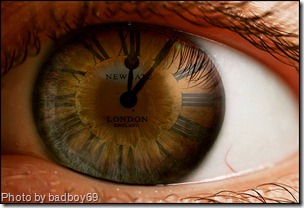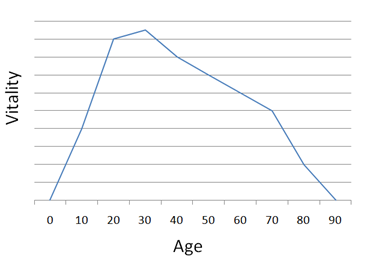How the Psychology of Time Can Help Channel Focus
with 6 comments
 How we focus on the passage of time can result in a significant bias when applied to everyday life. This bias could make all the difference in our relationships, our work, and our overall happiness. Philip Zimbardo, one of the most prestigious psychologists in the world and a part of the Positive Psychology movement, has recently turned his focus to time. His book, The Time Paradox, and his most recent online talks (#1, #2 – both recommended) have been all about time perspective and delayed gratification – or as he says, having a “healthy take on time”. Zimbardo holds a special place in my heart because he was the author of the textbook used in Psych 101 at Cornell University, which first piqued my interest in psychology. His new research on time fascinates me and in many ways speaks to what this blog is about.
How we focus on the passage of time can result in a significant bias when applied to everyday life. This bias could make all the difference in our relationships, our work, and our overall happiness. Philip Zimbardo, one of the most prestigious psychologists in the world and a part of the Positive Psychology movement, has recently turned his focus to time. His book, The Time Paradox, and his most recent online talks (#1, #2 – both recommended) have been all about time perspective and delayed gratification – or as he says, having a “healthy take on time”. Zimbardo holds a special place in my heart because he was the author of the textbook used in Psych 101 at Cornell University, which first piqued my interest in psychology. His new research on time fascinates me and in many ways speaks to what this blog is about.
Time perspective is about how we subjectively divide the flow of human experience into time zones or categories. We each create segments of reality through time using significant (or sometimes insignificant) events in our lives. Zimbardo calls this “subjective time” because it’s highly personal and unique to each of us. The way we approach time in general varies quite a bit and can easily become a bias as we’ll see.
The famous longitudinal marshmallow study, referenced in just about every positive psychology book these days, is a great example of how time orientation has an effect on who we are and what we do. If you haven’t heard about the study, it involved a group of 4-year olds who were given a marshmallow as a reward for completing a task. The kids were told that if they could hold off and not eat the marshmallow once left alone, they would receive another marshmallow. Of course, more kids than not couldn’t wait and ate the first marshmallow. They wanted instant gratification over delayed gratification, even though there would have been a better outcome through waiting.
When these kids graduated high school, they were interviewed by the researchers and there were significant differences across the board. The kids who were able to delay gratification and hold off eating the first marshmallow scored 250 points higher on the SAT and had far more positive personality traits than those who gave into the impulse. They were self-motivated, decisive, self-confident, and balanced. It pays to embrace delayed gratification.
If you’re interested, you can read more on the marshmallow study before going further.
 This strangely reminds me of Vanilla Sky, an otherwise lame-duck movie except for the description Tom Cruise’s character uses to describe his perspective on time: I’m a pleasure delayer.” I’ve always liked that.
This strangely reminds me of Vanilla Sky, an otherwise lame-duck movie except for the description Tom Cruise’s character uses to describe his perspective on time: I’m a pleasure delayer.” I’ve always liked that.
Zimbardo talks about three groups of people: present, past, or future-oriented. Naturally people can’t really be 100% in any given orientation, but it’s possible to have a strong leaning. Present oriented people make decisions based on what’s happening around them at that present moment – how things taste, look, feel, or impact them at that time. Past oriented people make decisions based on what’s happened before or on what they know or have seen or heard. Future oriented people are focused on what will be – always doing the cost/benefit analysis against their actions. All of us have some bias based on how we look at time – this bias influences all of our decisions even when we’re not aware of it – and most of the time, we’re not.
Now, generally it’s believed to be healthier to lean towards future-focus rather than present or past focus. People who are future oriented inherently avoid risky behavior and gravitate towards healthy activities: exercise, dental checkups, eating healthily, and so on. They usually don’t drink excessively, do drugs, or smoke. A joint study done at Stanford and Cornell with 1200 students showed that the more present-oriented you are, the more you use alcohol and engage in risky driving behavior. This behavior can be justified through a “you only live once” mentality, which to present-oriented people means “the future isn’t as important as the present”.
Zimbardo then breaks time orientation down further into 6 distinct profiles:
- Past positive. View of one’s past is generally positive.
- Past negative. View of one’s past is generally negative.
- Present hedonistic. Where we all start in life! Focused on the joys of life right now.
- Present fatalistic. Things don’t matter, your life is out of your control.
- Future goal oriented. Working towards overall goals.
- Future transcendental. Life begins after death.
Given these definitions, the target profile according to Zimbardo is:
- Moderately high on past positives
- Moderately high on future goal oriented
- Moderate on (a “dash” of) present hedonism
- Low on past negative and present fatalism
People who fit this target profile are able to view their past positively while keeping the future in focus when decisions are made, all the while occasionally indulging in activities that result in pleasure in the present. They’re not dwelling on the negatives in their past (even though they have them just like everyone else) or taking a “this doesn’t matter anyway” approach to the present.
While this profile is ideal, you must also be able to change perspective fluidly depending on the situation. Without the ability to move in and out of different perspectives, you’re “stuck” with a single view which can increase the bias in which that perspective has on your outlook. For example, you need to be able to shut off your past and future perspectives at times to get things done, knowing it will bring you closer to your goals and increase the possibility of generating new positive memories. And once you get through the grind, you can feel OK about rewarding yourself in the moment with a little chocolate 😉
For me, time perspective hits home with respect to aging and the road of life. My own time perspective profile maps almost exactly to the target profile above, which I’m happy about: I view the past with a lot of joy and some nostalgia. I have many great memories with friends and family and do my best to capture them and look back on them from time to time. I look to the future on a regular basis to map out a plan for the short and long-term, but I try not to get “stuck” there so I can be in the present moment. And I definitely indulge in some present hedonistic activities (as I sip on a yummy cappuccino right now).
But despite this, I have a view of aging that can lead to a “good old days” mentality, indicating an occasional slip to an overemphasis on “past positive”. All around us people talk about how getting old sucks – there’s more aches and pains and fewer simple joys in life. In sports, the day you turn 30 all anyone talks about is how everything’s downhill from that point on. Couple this with the perception that as you get older, life speeds up, and this can lead to a fatalistic view of the future (old age and death are rapidly approaching). As is typically the case, I’m working to reframe my perspective using images.
My past (and occasionally current) view of aging looks more like the view as seen by those sportscasters – peak at 29 and begin the gradual decline into old age, eventually dying a frail, sad human being.

But that isn’t accurate at all. And it’s not the kind of belief I want to cultivate in my mind. You are what you focus on. So I’ve decided to replace that depressing visual with something that looks more like this: 
Life is a journey, not a chart! What’s the point in believing I’ve already peaked?
So what can you do to change your perspective if you find yourself biased in one way or another? Here are some links to posts that may (or may not!) help.
- Plan your life with a focus on the future (this post is mostly about project management techniques)
- Practice goal setting and refer back to your goals from time to time
- Use productivity methods to get on top of things and free up your time
- Indulge in pleasurable activities in moderation (what I’ve also called micro-vacations)
- Practice being mindful and living in the moment when you can (find flow!)
- Form new habits (and leverage neuroplasticity)
- Look at your past through a positive lens (if it helps, takes lots of photos and videos!)
To learn more about time perspective and the psychology of time, I’d recommend checking out The Time Paradox by Philip Zimbardo and John Boyd.



